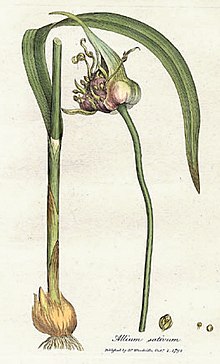 Allium sativum, commonly known as garlic, is a species in the onion family Alliaceae. Its close relatives include the onion, shallot, leek, chive,[1] and rakkyo.[2] Garlic has been used throughout history for both culinary and medicinal purposes. The garlic plant’s bulb is the most commonly used part of the plant. With the exception of the single clove types, the bulb is divided into numerous fleshy sections called cloves. The cloves are used for consumption (raw or cooked), or for medicinal purposes, and have a characteristic pungent, spicy flavor that mellows and sweetens considerably with cooking.[3] The leaves, and flowers (bulbils) on the head (spathe) are also edible, and being milder in flavor than the bulbs,[2] they are most often consumed while immature and still tender.
Allium sativum, commonly known as garlic, is a species in the onion family Alliaceae. Its close relatives include the onion, shallot, leek, chive,[1] and rakkyo.[2] Garlic has been used throughout history for both culinary and medicinal purposes. The garlic plant’s bulb is the most commonly used part of the plant. With the exception of the single clove types, the bulb is divided into numerous fleshy sections called cloves. The cloves are used for consumption (raw or cooked), or for medicinal purposes, and have a characteristic pungent, spicy flavor that mellows and sweetens considerably with cooking.[3] The leaves, and flowers (bulbils) on the head (spathe) are also edible, and being milder in flavor than the bulbs,[2] they are most often consumed while immature and still tender.  Additionally, the immature flower stalks (scapes) of the hardneck and elephant types are sometimes marketed for uses similar to asparagus in stir-fries.[4] The papery, protective layers of “skin” over various parts of the plant are generally discarded during preparation for most culinary uses, though in Korea immature whole heads are sometimes prepared with the tender skins intact.[5] The root cluster attached to the basal plate of the bulb is the only part not typically considered palatable in any form. The sticky juice within the bulb cloves is used as an adhesive in mending glass and china.[2]
Additionally, the immature flower stalks (scapes) of the hardneck and elephant types are sometimes marketed for uses similar to asparagus in stir-fries.[4] The papery, protective layers of “skin” over various parts of the plant are generally discarded during preparation for most culinary uses, though in Korea immature whole heads are sometimes prepared with the tender skins intact.[5] The root cluster attached to the basal plate of the bulb is the only part not typically considered palatable in any form. The sticky juice within the bulb cloves is used as an adhesive in mending glass and china.[2]
[youtube=http://www.youtube.com/watch?v=rEJbfJlkfCs]
[youtube=http://www.youtube.com/watch?v=55TTL2he9lE]
[youtube=http://www.youtube.com/watch?v=ll_gCnBYHB0]











